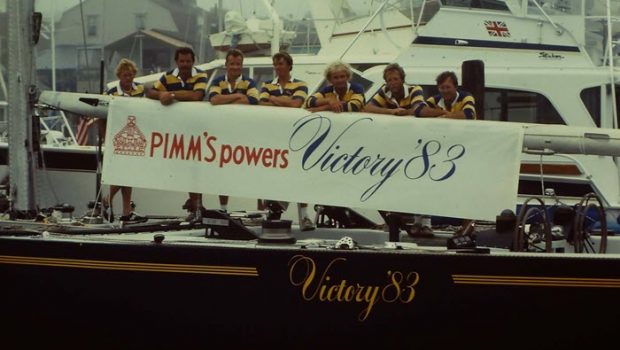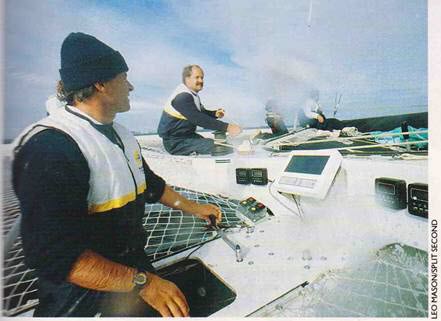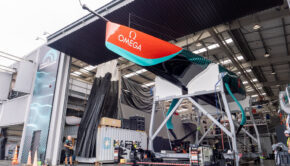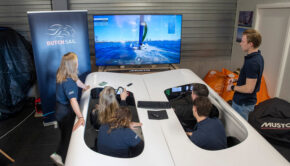Rugby shirts and the America’s Cup
Published on November 6th, 2022
With the passing of Peter de Savary, David Redfern reflects on his time working for the backer of Britain’s formidable America’s Cup challenge.
Joined by Royal Burnham Yacht Club member Kit Hobday, Peter decided around 1979 to challenge for the 1983 America’s Cup. Sensibly, they thought it would be a good trial to see if they could create a successful IOR boat, which they did by campaigning the Ed Dubois designed Victory of Burnham in the 1981 Admiral’s Cup, winning their sector.
A legacy of that event is seen worldwide today in that Peter wanted the crew to look like a proper team and not just a collection of sailors, so his boat manager Jim Alabaster went to Lilywhites sports shop in London’s Piccadilly and came back with a mountain of Rugby shirts in blue and yellow stripes plus matching socks etc. This was the first use of Rugby shirts in sailing, and the distinctive team uniform was to be continued throughout his sail racing days.
Having successfully campaigned with Victory of Burnham, Dubois was enlisted for the 12 Metre yacht Victory ’82 (K-21), but his design was not the greatest of the 12s and work began with a consortium of designers to create a new Victory ’83. Aluminum boat building was in its infancy at the time and problems of distortion in the welding processes were part of the problems with K-21.
Aircraft manufacturers were looked at, including British Aerospace now BAE, but they were too busy. Eventually Fairey Allday Marine was commissioned to build Victory ’83 (K-22), financed by a levy on rentals in Peter’s newly built St James Tower in New York, which was used in the Leonardo DiCaprio film The Wolf of Wall Street. It was one of the last unsponsored privately funded challenges.
Designed principally by Ian Howlett with a team of Britain’s best designers, K-22 was altogether a much better yacht. During the design process, an innovative keel design was proposed with a wing at the bottom of the blade. To keep it secret, a confidential ruling was sought and it was declared legal.
This was to have far reaching consequences for Australian team owner Alan Bond and designer Ben Lexen when the New York Yacht club contested the legality of Australia II’s wing keel. Peter gave Ben Lexen his letter of approval and that collapsed the NYYC argument, which Ben referred to it in his book as a gracious moment.
As a newcomer in its first America’s Cup, Victory ’83 fought off all the challenges to sail against Alan Bond’s Australia II in the final of the Challengers Series. While not strong enough to win, it should be noted that this was Alan Bond’s fifteenth year of America’s Cup involvement so Peter had done really well in a first challenge.
His campaign headquarters for the 1983 America’s Cup challenge was a veteran Glasgow built yacht previously owned by Elizabeth Taylor and Richard Burton. With a giant inflatable bulldog on its aft deck, it was hard to be missed.
During the campaign it was known that USA and Australia were great team players, which was something the British have not always been, and mischief was made to try and destabilize Dennis Conner’s team.
For example, a powerboat set out to follow Dennis in his trials, pointing satellite dishes at his 12 Meter. It was conveyed to be secret equipment from our sponsor which allowed us to hear everything that was said on the boat. It was of course nonsense and the dishes were no more than trash can lids, but it caused Dennis enough stress to get a restraining order to keep our team more than a hundred yards away!
The following year, Victory ’83 beat Australia II and all other current twelves in the Class World Championship in Porto Cervo, Italy. The continued success launched aspiration to challenge for the 1987 America’s Cup in Perth, Australia.
A sponsor, a major international cigarette company, was about to sign the dotted line for big money when the Premier of Western Australia banned cigarette sponsorship. Another sponsor, the Del Monte Company was also close to a sponsorship deal until the principal of the company had to flee the country under arrest threats and left to live in Turkish occupied Cyprus.
Not able to participate, with Dennis Conner winning the 1987 edition, a challenge for the next America’s Cup in San Diego was launched and Blue Arrow, a worldwide recruitment company, incorporating Manpower in the United States, put up £12m underwriting for the campaign.
Peter had earlier bought the Docks and Ship repair yard in Falmouth and created a super yacht building business called Pendennis Shipyard. A new yacht club was formed – Pendennis Yacht Club – and a challenge was made.
This time, the most radical America’s Cup yacht ever built at that time emerged as a monohull, complying with all the requirements of the Deed of Gift but with an extraordinary design that gave the appearance of a trimaran but was definitely a monohull capable of 35 knots plus. There is footage of the yacht sailing in Falmouth in an IMAX film on sailing.
However, the Challenger of Record against the San Diego Yacht Club was Michael Fay for New Zealand. A letter accepting the Blue Arrow challenge was received from Michael but he had not at that time seen the radical design, being busy creating his 120-footer. When he realized the potential for Blue Arrow, he cancelled the Challenger Series.
I spent days with Peter, Alan Bond, and others trying to persuade him to change his mind, but he was adamant. It was an odd situation. Both groups were negotiating in the same hotel with the Kiwi group on one floor, our group on another, never meeting in person but passing messages between each other.
With the death of the Challengers Series, and Peter unable to compete again, he now retreated to gentler sailing restoring a Herreshoff schooner, Vagrant at a shipyard in Antigua. He married Lana on the boat in the harbor of his new creation, The St James’s Cub.
It was from then on that I moved on to other projects in his massive industrial and leisure empire and eventually left in 1985 for other sailing related projects, including sailing 3500 miles on a replica caravel to commemorate John Cabot’s journey of 1497 to the New World which he called Newfoundland.
Life was very exciting with Peter. We only ever had one argument, and that was my fault. He will be a hard act to follow and I would put him alongside Lipton and Sopwith for his energies and love of sailing. A great and too early a loss to the sport.
More about Blue Arrow:
The radical boat was conceived and built in just eleven weeks. The design team was led by Derek Clark with Rob Humphreys, Tony Castro, and Ed Dubois. It appeared on July 20, 1988 in Pendennis Shipyard, Falmouth.
The first sail was with Jo Richards at the helm and immediately hit 17 knots under just mainsail. The two-foot-wide monohull was supported by a 60-foot cross beam with a keel at each end. The cross beam was capable of being moved forward and back by about two feet, complying to the rules that there may be sliding keels.
The genius was how the keels had wings like aircraft ailerons that were controlled hydraulically with a rotating handle controlling the oil pressures. This kept Blue Arrow almost level in any conditions, creating great speed and incredible acceleration. She was doing 30 knots in 18 knots of wind and no doubt with further development would have gone even faster.











 We’ll keep your information safe.
We’ll keep your information safe.